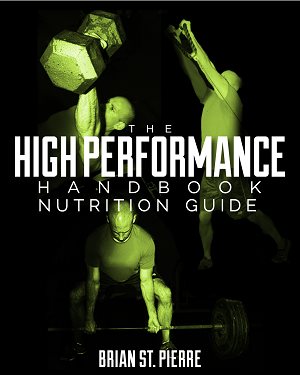You Asked, I Answered.
Filed under: General Health, Nutrition, Training
Before we get started today I wanted to mention that Jim Smith has released another cool free video demonstrating some of his training methods for his awesome Accelerated Muscular Development 2.0. It actually walks you through an AMD2.0 workout, so check it out!
Q. What are your thoughts on the latest study I saw on the news about too much vitamin D (i.e. over 600 IU) could be risky because of developing calcium deposits (or something like that)?
A. Well I will first say that it was not a study, though the article made it seem that way. It was a report based on studies, conducted by a very conservative agency.
I also did not like how the tone of the article made it seem that taking more than 600IU of vitamin D would be dangerous, it is most definitely not. Now taking more than 10,000IU per day might be, but I stress might, because there is research showing even that amount to be safe, and it would require really long supplementation at that dose to be problematic. In fact the research seems to indicate that to actually achieve vitamin D toxicity and its associated negative effects (such as calcium deposits, nausea, etc), it would require supplementation of 40,000IU per day. I still wouldn’t recommend taking 10,000IU per day though as it seems unnecessarily high, unless that dose is what it takes to get you into the normal range (you should be able to drop to a much lower dose to maintain that level).

The recent research that has shown problems with vitamin D supplementation has been widely refuted by other researchers for design and methodology flaws, so it can be difficult to know what is what. It is in the minority, a tiny minority at that.
The fact of the matter is that most people today do get very little sunlight and should supplement with some vitamin D, the key is to know the amount needed to achieve optimal blood levels for you. That number may vary by person and I think more research is needed to find out if that value is dependent on genetic or other factors (race, smoking, bodyweight, diabetes, season, etc). As of right now the ranges most often given are 30-80 ng/mL. Above and below those numbers is not a good idea, and it is probably best to aim for a moderate level of about 50 ng/mL.
Now having said all of that, there may be some people with certain genetic variants or other conditions who should definitely not take large doses of vitamin D. People are also trying to link other complications to vitamin D supplementation, and it should be noted that this might be a possibility. All essential nutrients are part of a much larger whole, and work synergistically together, modifying each other’s effects. Taking huge doses without getting tested is probably not a good idea. Find out what your starting blood levels are, supplement appropriately (take 1,000IU for every 10 ng/mL you need to increase) and then get retested.
While I do think that people shouldn’t go crazy with their vitamin D supplementation, the vast majority of the research supports the notion that taking 4,000-5,000IU per day is safe. Personally, I required about 5,000 IU to achieve a blood level of 55 ng/mL. I am going to play around with cutting my dose down to about 2,000-3,000 IU per day and retest. If I can maintain at that dose then that is what I will do. Again, getting your levels tested is key.
Check out the BSP Training & Nutrition Newsletter!
You will get immediate access to:
- Weekly updates and exclusive content.
- The 20-page report "The Truth About Saturated Fat & Cholesterol."
- Become more awesome!
Posted on December 2nd, 2010 by Brian St. Pierre
11 Comments




December 2nd, 2010 at 10:30 am
Thanks for this post Brian. I was curious when I read an article about this yesterday, and am grateful for your (as always) sound interpretation and assessment. Keep doing what you’re doing, your blog is great!
December 2nd, 2010 at 2:44 pm
Brian, can you just go to a normal doctor to get the testing done to see how much vitamin D you need or where?
December 3rd, 2010 at 4:11 am
Jill,
Thanks, I appreciate the kind words!
Richard,
Yes your primary care physician is able to get your vitamin D tested. Some are hesitant, but it is your right as a patient, so insist.
December 4th, 2010 at 3:28 pm
[...] You Asked, I Answered (Brian St. Pierre) – BSP on Vitamin D safety. [...]
December 8th, 2010 at 11:30 am
[...] Too Much Vitamin D? – This great Q&A from Brian St. Pierre addresses this new question that seems to be popping up quite a bit. [...]
December 9th, 2010 at 12:18 pm
Brian,
Did you notice/feel any difference when you got your vitamin D levels in the range you wanted?
December 10th, 2010 at 2:59 am
Todd,
Well it is not like caffeine where you feel this immediate impact, but I can most definitely say that my immune system is stronger from taking it.
Prior to supplementation I rarely got sick (I didn’t miss a day of high school actually), but I would usually get 1-2 colds per winter. Since I have been taking vitamin D, I have maybe gotten 1 cold in 2 years.
When my wife came down with the swine flu last year I stayed home from CP one day to take care of her, didn’t catch a thing. Now this isn’t definitive proof of anything, but it certainly doesn’t hurt.
More anecdotal evidence is I had a friend supplement last winter who usually ends up kinda down in the dumps by the end of winter. He informed me that his mood was improved and he didn’t get depressed like he usually did after using vitamin D all winter.
Just some food for thought.
Brian
December 16th, 2010 at 3:17 pm
Hi Brian,
Let me first say I agree D3 is a worthwhile supplement to take on a daily basis, and I have no vested (i.e., career) interest in whether the recommended intake of D3 increases or decreases. I am simply a methodologist/statistician who thoroughly understands the methodological shortcomings of this literature. I have served as lead statistician on numerous studies out of endocrinology (among many other areas and disciplines) and simply let the numbers do the talking! What is provided below is my honest, unbiased methodologist’s view of the D3 literature.
With that said, I purchased your supplemental Nutrition Guide with Eric’s Show & Go that was filled with great information, but I cringed when you stated you can safely have serum 25(OH)D of 50-80ng/mL. You not only have an incredibly high range, but your language indicates individuals should be on the high end of this range. You even go so far as to insinuate a reader with serum 25(OH)D of 20ng/mL could never get into your recommended range without ingesting an unsafe dosage of D3.
Nevertheless, I digress. I believe you should reconsider your quick critique of the review article describing the Institute of Medicine’s (IOM) daily D3 recommendations, and, further, reconsider your own recommendations to your clients and readers! The IOM recommended an optimal serum 25(OH)D of 20ng/mL. This recommendation was not only to maximize protection to the public, but was based heavily on the consistently emerging body of literature suggesting the benefits of increasing D3 intake plateau with serum 25(OH)D around 20ng/mL. Thus, there is absolutely no reason to increase dosage to increase serum 25(OH)D if no additional benefit is observed. The IOM go on stating individuals can safely ingest to 4000IUs of D3 daily; however, this is the threshold where adverse events have been shown in the literature. That is, ingesting more than 4000IUs is associated increased probability of adverse events. In addition, you are clearly aware that studies have shown serum levels above 50ng/mL increase the probability of adverse outcomes (e.g., kidney stones), especially with younger adults, but whether you choose to recognize these studies is debatable.
There is no doubt in my mind that you already knew some (or all) of this information. Coming from someone who just plain understands research, I urge you to critique studies suggesting health benefits of D3 with the same rigor you applied to studies suggesting adverse events. Any D3 study suggesting an increased health benefit must be viewed with caution—aside from probably the benefits to bone health, which has been shown to be a most consistent finding. No long-term safety studies for D3 have been published. This is a HUGE consideration. Further, you were quick to state that research suggesting adverse events with D3 supplementation are flawed methodologically, but you fail to state that ALL research is flawed. This includes studies suggesting health benefits of D3, which are essentially association studies that are inherently unable to imply causality. Further, if believe you are adequately critiquing the literature, you obviously know statistical significance (i.e., p < .05) means nothing. Thus, you already know that any D3 study with a large enough sample is guaranteed to indicate statistical significance. If you didn’t know this, however, then I recommend finding an individual with a background who can explain the literature to you, in an unbiased manner. It will make you a more informed nutritionist who is able to project ACCURATE information to your clients and readers!
Best,
Walt
December 17th, 2010 at 9:52 am
Walt,
While I appreciate the well thought-out comment, I do not appreciate the condescending tone. Yes I do understand the limitations of statistical significance, and I do know that most of the vitamin D data is based on observational studies, but there are actually many controlled trials on vitamin D supplementation above 600IU showing many benefits. As for pointing out the flaws, I simply stated that other vitamin D researchers have pointed out the flaws in the methodology, not me. I am not a vitamin D researcher.
However, here are a few items for you to consider. The IOM wants people between 20-29.9ng/mL because in their estimation that provided the best protection for bone health, they did not state that only 20ng/mL is the optimal number. There is a lot more to vitamin D than bone health.
Beyond that, there are many researchers on vitamin D who roundly disagree with the recommendation. One would be Robert Heaney of Creighton University, one of the leading bone researchers in the world. He recently wrote a letter to the Annals of Internal Medicine about some literature reviews that they had published on vitamin D. In it he stated that doses ranging from 4000-5000IU/day (to reach 30-40ng/mL)are not high, and are actually within our normal physiological range since these values are consistent with those found in healthy individuals living in conditions similar to our ancestors. He also pointed out that outdoor summer workers often have blood levels of 48 to 80ng/mL, without reported adverse affects. In fact, the National Institutes of Health states that the normal range for vitamin D status is 30-74ng/mL.
And since we are on the topic, lets take a look at a recent controlled trial on vitamin D supplementation. A recent 16 week study compared supplementation of 400IU/day to 2000IU/day. 2000IU/day beat 400IU/day in every measure. The vitamin D status in the 400IU group went from 13.6 to 23.9ng/mL (in your optimal range), while the 2000IU group went from 13.3 to 34.3ng/mL (in my optimal range). Aortic stiffness decreased and body fat mass was inversely associated in the 2000IU group, while the 400IU group actually had an increase in aortic stiffness and no association with body fat mass.
Granted that is one study (and there are many more), but it did find that more than 29.9ng/mL did provide greater benefit than being below it. Seems to be an additional benefit to me.
We also know that pregnant and lactating women need more vitamin D. It has been shown that breast-feeding women need at least 2,000 to 4,000IU/day to normalize their vitamin D status, and to normalize the vitamin D status of their feeding baby. Less than that is ineffective.
Now would I have worded the Show and Go recommendations differently if I were to write it now, probably yes, but I don’t think it was the evil you have made it out to be. To get from 20ng/mL to my stated range of 50-80ng/mL would take approximately 3000IU/day, which is below the IOM upper limit of 4000IU/day, how is this dangerous? You also state that research has clearly shown that intakes above 4000IU/day is associated with increased probability of adverse events. Where is this research? The IOM also stated that 10,000IU/day might lead to toxicity, yet they did not produce any reproducible evidence that that level has ever caused toxicity in humans.
The data on vitamin D is certainly not conclusive, but since we know that at least 30-40ng/mL (and higher) is normal in people living in conditions similar to our ancestors (ie – getting plenty of sunlight and eating real food), I don’t see how that range is dangerous. Might different populations have different ranges? Yes, possibly. Might being near 80ng/mL not be the best idea? Yes, possibly (though many researchers and the vitamin D council would disagree). Is 20ng/mL optimal? No, and the research does not agree with that (I just showed one example of many). What is optimal? It depends on many factors, but I think being anywhere from 30-50ng/mL is probably a pretty safe bet, though individual differences are definitely possible, and there are populations who might not want to elevate their vitamin D status.
To cap this off, the Institute of Medicine consulted with 14 vitamin D experts about their recommendations. These 14 experts all provided reports on the recommendation, and yet these 14 reports have been suppressed. They won’t let us know what these vitamin D experts (including Robert Heaney) had to say about their report, interesting… Also of note the Canadian Cancer Society, the Canadian Pediatrics Society, and Osteoporosis Canada all decided to maintain their current recommendations of 800 to 2000IU/day of vitamin D, despite the IOM report.
Like I said in the blog, get yourself tested. You should know your levels before you start supplementing, to know where you are compared to where you want to be. Discuss your results with your doctor, and most importantly, educate yourself.
December 17th, 2010 at 11:04 am
[...] recently wrote a blog refuting the recent IOM report on vitamin D, because I believe, along with the leading vitamin D researchers, that the report was off-base and [...]
December 30th, 2010 at 4:05 pm
[...] research supporting higher doses was overlooked for the analysis. He outlined his points in a brief article on his site which resulted in some particularly detailed correspondence with one reader and which [...]